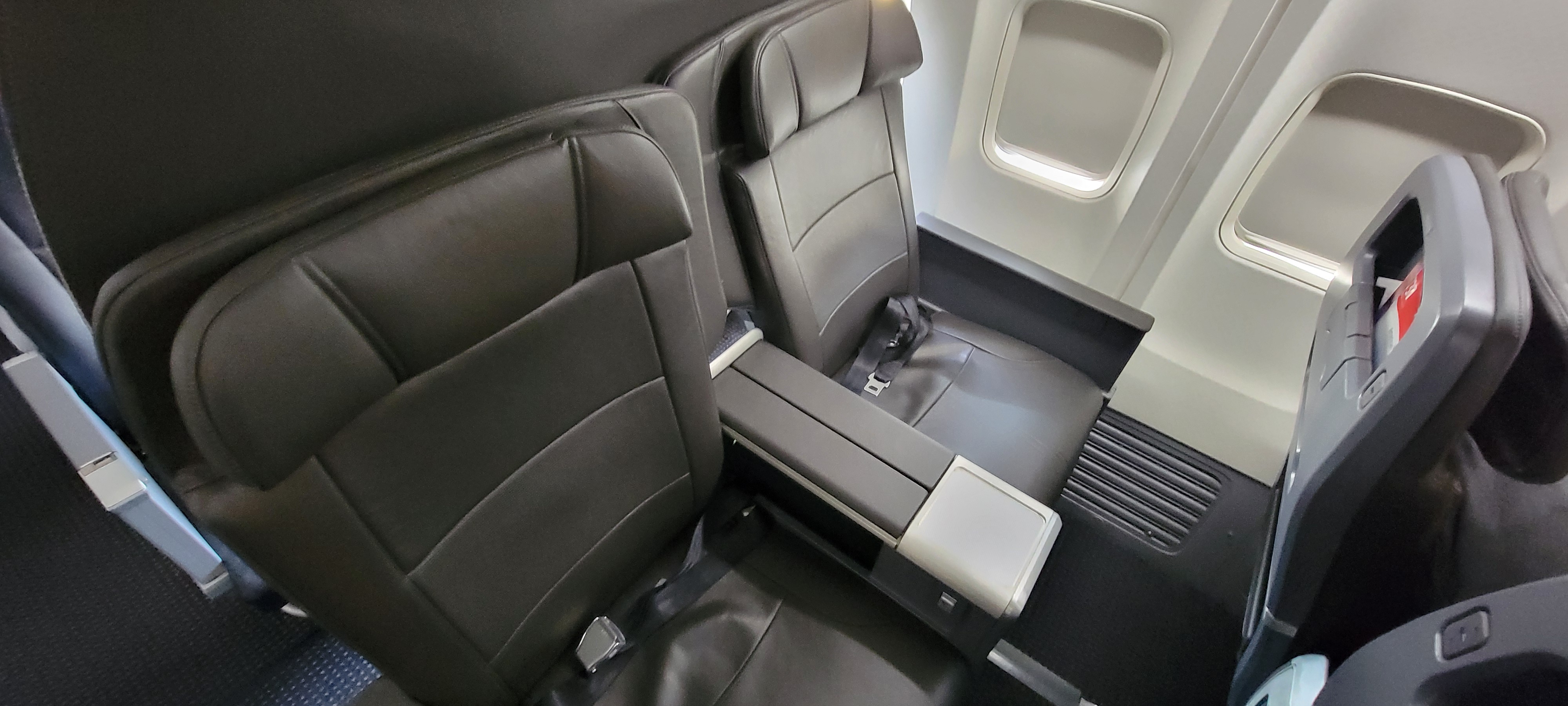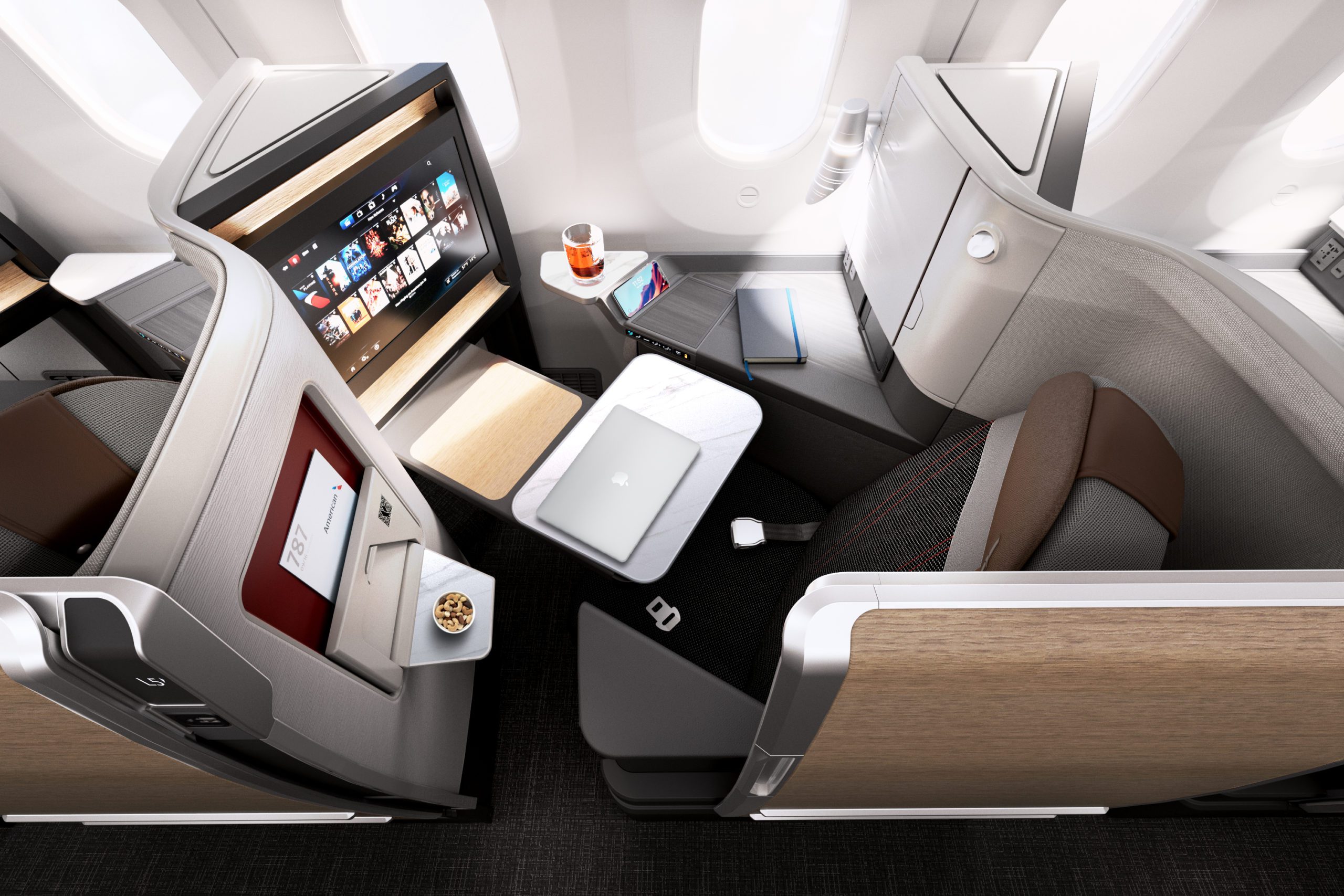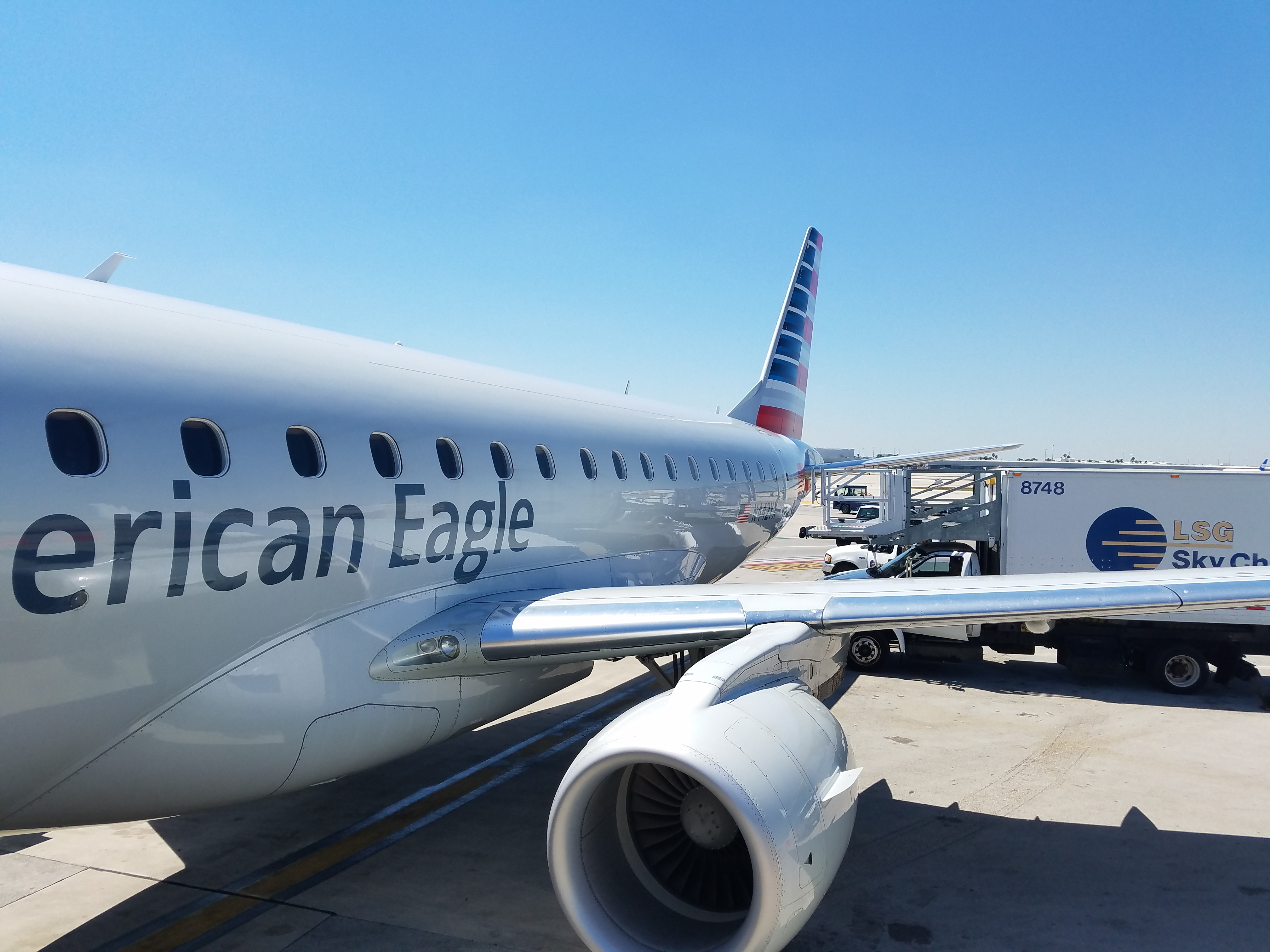American Airlines lost $149 million in the third quarter, while their two major competitors made about a billion dollars each. It’s being reported as an earnings beat relative to forecasts, and… I guess? A month into the third quarter they expected to break even.
If you don’t count $354 million in expenses largely from the new flight attendant contract, they’d have earned 30 cents a share.
- It’s true that those are one-time expenses but they are a regular part of doing business and you can’t wave those costs away.
- There are always one-time costs in the business, every quarter!
The stock opened down on the news, when the market was overall flat and both Delta and United shares performed better.
They attribute their problems to the self-own of walking away from managed business travel, but that alone doesn’t account for the gap with competitors and in the third quarter they boosted this segment by only 6% year-over-year.
Premium revenue was up 8%, paid premium load factor was up 4%, and loyalty revenue was up 5% year-over-year. During the third quarter earnings call, CEO Robert Isom reported that 72% of premium revenue came from AAdvantage members. But baseline premium revenue lags, which doesn’t work with high and rising costs. Revenue per seat mile actually fell by 2% in the quarter.

CFO Devon May said he considers them as being “best in the business at managing expenses” the past couple of years, aside from trying to lure back corporate customers they don’t articulate a strategy to drive increases in premium revenue other than having more premium inventory to sell. (Cost-cutting will remain a focus, with growing efforts in AI, taking an “AI lens to everything we do” – already they are “growing the airline by 5.5% but growing staff by only 1%.”
In terms of progress on a new credit card co-brand agreement, Vice Chairman Steve Johnson reported timeline “progress as the bottom of the 7th inning at this point.” It was reported as being in the fifth inning in July. In terms of whether they’d be consolidating their partnership with Citi, to the exclusion of Barclays, he offered just that they have “two really exceptional friends and partners in Citi and Barclays.”

They tout beating their major competitors in completion factor, driven by recovering better from CrowdStrike than United and Delta. They tout this as their operational reliability, but:
- If they get to exclude one-time costs, shouldn’t they exclude one-time operational disruptions from their competitors?
- Overall they don’t operate better – consistently losing more bags, involuntarily denying boarding to more passengers, and they just received a $50 million fine for mishandling wheelchairs.
J.P. Morgan’s Jamie Baker asked about where they’ll look to improve their network, and whether that’s a priority? Robert Isom says they have a great network, rather than plans to improve it – citing their partnership with Alaska on the West Coast, what they tried to do with JetBlue on the East Coast, and that they will fly more from New York than any time since the pandemic (damning with feint praise) and partnering with BA to Heathrow.

Credit: American
In terms of what customers want, an analyst asked about United’s free wifi efforts with Starlink, and Isom said they’ll sell more premium seats and allow more self-service via their app, and they installing fast (paid) wifi on large regional jets.

Isom is right in answering a question about whether American would match competitors Delta, United, Southwest and JetBlue in making their miles not expire and he offered that in all of the various assessments AAdvantage miles stack up well in value against those currencies and that their focus is on providing more value for customers than other carriers. AAdvantage was a key pillar of their investor day earlier in the year. Non-expiring miles is an investment in infrequent customers and whether that’s a smart bet or not it’s not where I’d prefer to see them invest.
American doesn’t articulate a plan to get customers to pay more for their product. If anything, more premium seats (increased supply) might push down price. They consider what they offer (seats, lounges) to be good. And they don’t have a new network strategy either – they’re happy with where they fly. “If you always do what you’ve always done, you’ll always get what you’ve always got.” The airline has destroyed more shareholder value than any U.S. carrier in history both inside and outside of bankruptcy.
Ultimately they should see some mean reversion in corporate bookings, but they’re unlikely to become a leader. They don’t have a strategy to better than today in key markets like New York, Chicago, Los Angeles and San Francisco. They don’t have a strategy to get customers to pay more to fly American than competitors – which will become even more crucial with their higher costs, and as the supply of premium seats grows. AI and cost-cutting alone is not a vision.


AA’s yield decline worldwide was far higher than other airlines while their load factor was up. AA is simply pushing the limits of its ability to carry more passengers while not fixing their revenue underperformance.
Lower fuel prices and interest expense due to lower interest rates more than offset what AA did in terms of revenue
And since the majority of their one-time charge was FA retro expenses, it is part of the cost of doing business and was obviously going to be necessary when DL settled with its pilots as first of the big 4 and then started multiple pay raises for its FAs.
The only thing of note is that UA loves to tout how well it is doing but has not settled with its FAs. The cost to AA for its FAs will mirror what UA will have to spend.
Anyone who has previously flown in an American Airlines 737 Oasis economy seat knows the discomfort of flying with American Airlines. To get me back as a paying regular customer, they have to defenestrate each and every Oasis seat on their planes and replace them with something someone can sit on for at least two hours. Until then, I will use my banked miles to go to places that their competition do not yet go. When I run out of AA miles, I will officially wave buh-bye to American Airlines.
I demand eighteen inch wide seats for my rubenesque glutes! So far, Delta and jetBlue seem to be the only ones that can provide.
If you ask me, AA only losing $150 million is a positive surprise. Sure they have lots of challenges but I thought they would lose even more money.
Why doesn’t Elliott buy a ton of AA shares on the cheap and demand changes like they did with WN? It seems like there’s nowhere to go but up.
Something needs to happen.
I have been shopping for a ticket from LHR to MIA in April. AA wants over $2000 for an economy one way ticket. I will swim it before giving AA that kind of money.
Isom also said that Boeing is creating problems for AA – likely meaning that AA would like to retire some aircraft but cannot because Boeing can’t deliver aircraft.
AA, WN and UA have all been vocal about the impact Boeing is having on their business models.
AA has long had a policy of buying from both Airbus and Boeing. Airbus is delivering largely on-time to AA. UA will get more aircraft from Airbus than Boeing this year.
Airbus did pre-delivery testing for 4 different aircraft all bound for DL from all 4 of Airbus’ commercial families. DL will get more than twice as many new widebodies from Airbus than Boeing will deliver to the entire rest of the US industry, AA, HA and UA
AA could be dangerously close to being in the same situation as WN – having to spend much more to keep older aircraft it doesn’t want and then shrinking its fleet because Boeing is not delivering aircraft needed for replacement.
AA Flagship lounge is alright; but that usually means flying AA when I can’t fly BA. Why can’t too-big-to-fail AA get more pandemic money from the US taxpayers and buy some nice Starlink-equpped A340’s and A350’s for the routes I choose?
Jet Blue has a chokehold in the northeast. American reduced capacity in BOS and EWR significantly last year.
They need to hire a new revenue management team. There is always room for improvement in monetizing ancillary fees and paid upgrades.
Finally they will need to go all 787 fleet and phase out 777 for long term efficiency.
@Tim Dunn “Isom also said that Boeing is creating problems for AA – likely meaning that AA would like to retire some aircraft but cannot because Boeing can’t deliver aircraft. AA, WN and UA have all been vocal about the impact Boeing is having on their business models.”
They’ve deferred delivery of some 787-9s. Sure long-term they’ll need to retire some 772s. But I suspect the comments about Boeing are more continued positioning over long-term compensation and deflecting blame for performance onto Boeing than actual desire for new planes quicker.
“Airbus is delivering largely on-time to AA.”
Please see the order book for the A321XLR.
LOL they are still so clueless. I have status on both AA and DL–for personal travel I’ll fly whatever makes sense for me, which for next week is a $500 one way J ticket LAX-BOS. Delta is charging $200 more than that. It’s great for me, but must be brutal for AA that they can’t charge similar fares.
The XLR is a new model and still is on the verge of being delivered far closer to schedule than Boeing is for either MAX model.
And it is far from clear that AA will get even the 787s it has on order for delivery now.
feel free to ask Isom what he meant but his comments were real. Airbus is a more reliable supplier to AA than Boeing is
and AA is not alone
@ Gary — AA will be bankrupt and merging with some other bankrupt airline soon enough. Parker can pocket a nice $50 million consulting fee for the work.
Yet they will again pay Robert Isom $35,000,000. at the end of 2024 in bonuses for a job well done!
Unfortunately their options are limited. Go for broke in LA or NYC and it doesn’t work out they will indeed go broke. Taking seats out of economy reduces revenue and doesn’t guarantee higher fares-remember MRTC. CLT is never going to be anything more than CLT.
I see wage concessions coming because that’s going to be the least painful (and it will still be very painful) to improve their bottom line.
“I demand eighteen inch wide seats for my rubenesque glutes! So far, Delta and jetBlue seem to be the only ones that can provide.” This isn’t an AA issue, it’s a Boeing vs. Airbus issue. The 320 is slightly wider than a 737. So, if you fly a 737, you’ll get =18″ of seat width on a 737, they’d lose one coach seat a row. And, today’s flyer wouldn’t pay the 20% (approx.) higher fare.
The Airbus wide bodies all have slightly more seat width than the Boeing “equivalent” for currently manufactured planes.
And nobody is mentioning the restructuring of corporate sales and the effect that has had on the bottom line, which to many estimates, is worth a billion per quarter.
Assuming that AA can recover corporate sales and the profitability that comes from it, it’s only a matter of time the airline can make meaningful investments in the fleet and inflight product as soon as debt levels normalizes to industry standard, projected to do so by 2026.
Robert Isom is a huge failure. I hope he retires soon, even if he takes his predictable undeserved multimillion dollar bonus on his way out. He just needs to get gone before he ruins AA completely.
I don;t understand why people want to see American Airlines liquidated and thousands of people to lose their jobs.
Not sure what the answer is but rarely fly them as I refuse to redeem 450,000 miles for a one way business class ticket abroad that was 80k previously
If They want a revenue stream make the program desirable
I think bankruptcy is near for american airlines!
Not true , they still made 13.6 billion
Record third-quarter revenue of $13.6 billion.
Third-quarter net loss of $149 million, or ($0.23) per share. Excluding net special items1, third-quarter net income of $205 million, or $0.30 per diluted share.
Led U.S. network carriers in third-quarter completion factor.
@Tim ja – revenue is not profit
“The Airbus wide bodies all have slightly more seat width than the Boeing “equivalent” for currently manufactured planes.”
The A330NEO does not have slightly more seat width than the Boeing B787 – thus your statement is incorrect.
I work for AA, and recently I have noticed the amount of premium pax have increased on our flights. I’m not taking AA side just because I work here, but I clearly see that they are finally listening to premium customers again. Maybe since Vasu’s departure they are luring back those clients?
My partner works for DL, and my best friend works for UA. They all have their pros and cons. We share a lot of our experiences when we meet up… and the feedback is so similar.
Most of us are very happy working for this airline, but not necessarily satisfied with the way Mr Isom has been running it. We will need a new CEO soon. AA has great hubs and network, they have to use them better though.
jacobin
it is absolutely true that, on average, the 787 as configured esp. by AA and UA, offer less total seat space than the A330 (the CEO and NEO are the same width so it doesn’t matter whether it is a NEO or CEO).
AA and UA both have chosen to configure their 787s in 9 abreast in coach and 10 abreast on the 777 which yields a smaller seat width than the 767 or A330.
while it is possible to have wider business class and premium economy seats, there are more coach/economy seats so the average for the fleet is still lower.
AA chose to get rid of its 767s and 330s so they have the lowest seat width not just in coach but across their entire international/widebody fleet, followed by UA, with DL offering the most seat width on its international fleet.
those are facts and you can’t cherrypick your way out of them.
When Brady Byrnes, SVP of Inflight and Premium Guest Services goes on CNBC and says “it doesn’t really matter what you serve on board” they’re going to lose my business. How he wasn’t fired the minute that interview ended is beyond me. A bunch of tone deaf incompetents running that airline.
@Joe – that comment is out of context, it was a piece on CNBC talking about American’s new catering facility